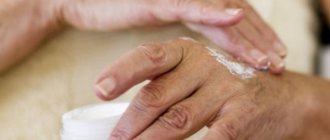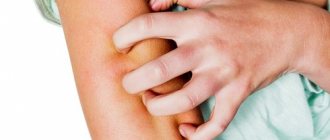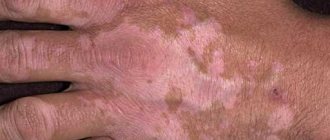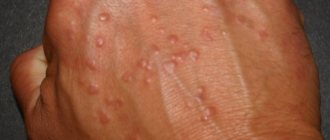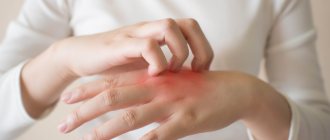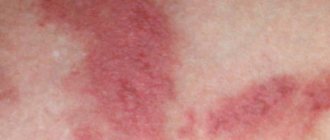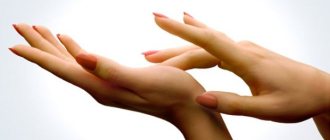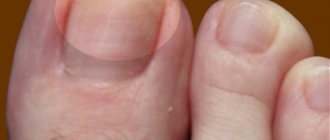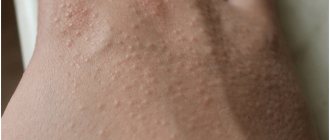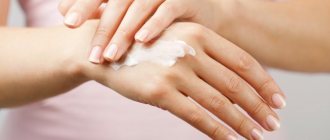Types of rashes on the palms and soles
The rash on the palms and back of the feet can have different shapes and shades. Often, rashes appear in the form of red spots formed from dilated subcutaneous capillaries. The pimples reach 3-5 mm in diameter and are accompanied by itching, peeling and weeping of the skin, and the formation of seborrheic crusts.
The rashes on the palms are usually not very pronounced, the skin turns red in the morning and may not itch much, but towards the middle of the day they disappear, leaving behind small whitish bags with liquid exudate. It will not be possible to squeeze out such a pimple, since the skin on the palms is stronger than on the face, and the rashes are localized on the hands in the deep layers of tissue. If there is fluid inside the pimple, it can cause tingling and itching sensations. When the rash is injured, pain occurs. It is not recommended to pick off the skin affected by the rash, in order to avoid the addition of a secondary bacterial infection.
The rash on the feet and palms comes in several types:
- pustule - a cavity containing mucopurulent exudate;
- plaque – an area of redness that is slightly raised above the skin level;
- papule - a tubercle that does not have a cavity inside; it can be felt through the epidermis;
- spot - an area of skin that does not rise above its surface, but is limited and has a changed color;
- vesicle - a cavity filled with clear or turbid liquid, reaching a diameter of 3 mm;
- bubble - a larger vesicle (up to 4-5 mm).
Important! With multiple rashes on the skin of the palms and soles, they can merge with each other, forming painful erosions. At the same time, the epidermis cracks, becomes wet, and constantly secretes ichor. Do not let the rash develop or self-medicate for a long time to avoid infection and dangerous consequences.
Types of acne
There are several types of acne:
- Dry, arising from exposure to air and cold.
- Watery, always accompanied by unbearable itching, which indicates scabies, dyshidrosis or childhood infections (rubella, measles, chickenpox).
- Purulent pimples caused by bacteria getting into wounds on the hands.
- Subcutaneous pimples caused by blocked glands.
Rashes on the hands have a different nature. Therefore, visiting a doctor is mandatory, otherwise complications are inevitable. You cannot make a diagnosis yourself by comparing the rash that appears with photos of similar diseases found in medical reference books.
Possible reasons
Rashes on the palms and feet do not appear just like that - it is important to promptly find out the cause of such symptoms. Factors causing skin lesions:
- impaired vascular permeability;
- changing the blood formula after operations, treatment of serious systemic diseases;
- reaction to medications;
- helminthiasis;
- infectious pathologies of a viral nature;
- fungal skin infections (mycoses);
- allergy.
A rash on the feet can appear due to yersiniosis - this is a disease of infectious etiology, accompanied by severe itching and burning, and general symptoms such as nausea and vomiting. On the palms and soles, the skin becomes bright red, reminiscent of the effect of gloves and socks. If the spots on the epidermis are large, with a brown tint, and peel off, psoriasis may be the cause. Typhoid, herpes virus, roseola are diseases that acutely manifest as a rash during a decrease in immunity. It is often impossible to determine the true cause of the rash on your own, which is why it is important to visit a specialist and undergo an examination.
Allergy
A rash that appears on the feet and palms in the form of blisters and severe redness may be a manifestation of an allergic reaction. The main irritants that provoke increased sensitivity are:
- household chemicals - a rash is the result of direct contact with allergens, which include washing powder, detergents, hygiene products, creams and lotions for skin care. The active substances included in such products enter into a violent reaction with the epidermis immediately after contact;
- food - the most common irritants are fish, soy, seafood, milk, honey, citrus fruits, chicken eggs;
- water – many patients have a pronounced skin reaction to chlorine contained in water, which is ingested and used for washing;
- medications - most often allergies are provoked by taking antibiotics, sulfonamides, ACE inhibitors. In women, a rash may appear after long-term use of oral contraceptives;
- house dust;
- pollen from plants - indoor and outdoor. The latter option involves the appearance of rashes during the grass flowering seasons (spring and summer);
- pet hair;
- mold spores on the walls and ceiling, invisible to the human eye.
When an allergic rash appears on the palms and soles, this fact can be linked to contact with foods, pollen and other irritants. If you carefully monitor the manifestation of symptoms, you can find out the main allergen and reduce contact with it.
Infections
A rash on the palms of children and adults is one of the symptoms of an infectious disease. It is important to take into account that during the incubation period a person may not realize that he is contagious to others. At the first acute manifestations of infection, the patient must be isolated. Pathologies accompanied by a rash on the feet, palms and other parts of the body:
- chickenpox – red spots appear on the skin, eventually filling with clear liquid. The process begins from the head, gradually spreading to the entire surface of the body, including the palms and the back of the feet;
- Rubella is a disease that is most often transmitted in childhood. It manifests itself as a rash on the face, spreading throughout the child’s body, down to the palms and feet, general malaise and fever;
- measles is an infection accompanied not only by rashes that merge with each other, but also by a dry cough and photophobia;
- Scarlet fever - the pathology begins with the appearance of small spots on the face, body, legs and arms. A distinctive feature of the disease is a bright red, almost crimson tongue and thickening of the rash in the elbow and axillary fossae. Pimples resemble dark red stripes on the skin. Additional symptoms – fever, hoarseness, weakness;
- Coxsackie virus - the rash is represented by small blisters containing liquid, localized on the palms, soles, and oral mucosa. At the same time, the patient experiences diarrhea and symptoms of intoxication.
On a note! Another infectious disease that causes a rash on the palms and soles of the feet is scabies. Pimples filled with liquid light exudate cause severe itching, burning of the skin, and are located mainly in the folds between the fingers. In advanced cases, the scabies mite bores passages under the skin on the stomach, thighs, and buttocks, leaving red stripes.
Other reasons
If your skin is sensitive, thin and prone to dryness, it may react to sudden temperature changes with a rash like prickly heat. Light pink pimples are located in the folds of the epidermis, mainly on the neck, under the knees, elbows, palms, soles, and buttocks. This rash can be treated by maintaining hygiene and maintaining optimal temperature conditions in the room.
A dangerous cause of rashes on the torso, arms and legs is meningitis. The rash appears on the face, spreading throughout the body, in the form of spider veins - from small bruises to large hemorrhages. At the same time, the patient’s well-being sharply deteriorates - the temperature rises, symptoms of intoxication, nausea and vomiting, and headaches appear. If you have rashes and the listed symptoms, you should immediately seek medical help.
A rash accompanied by itching and swelling of the skin, similar to an allergic one, but not treatable with antihistamines, is often caused by infection with helminths. With parasitosis, the body is poisoned by substances that helminths secrete during their life processes. With an increasing load, the human immune system produces an increased number of eosinophils - anti-inflammatory leukocytes. They are the cause of rashes on the feet, palms, stomach and back. Additional signs of parasitosis are anemia, alternating diarrhea and constipation, dark circles around the eyes, poor sleep, irritability.
Need to know! A rash on the feet also appears with type 2 diabetes, pathologies of the circulatory system, and problems with hormonal levels. Rashes are often caused by depletion of the nervous and immune systems. Vitamin deficiency also appears as red pimples, when due to an unbalanced diet there is a lack of minerals and nutrients.
Drugs to combat rashes - how to treat them
Treatment of an allergic rash involves eliminating the allergen, using antihistamines (externally and internally), enterosorbents (to bind and remove allergen particles from the body). In other cases, treatment of the underlying disease that caused the rash is required.
To combat the rash, the following can be used:
Gels
- Sinaflan (if itching bothers you);
- Fenistil (against atopic dermatitis).
Ointments
- based on dexpanthenol (with a healing and moisturizing effect);
- Syntomycin emulsion (antibacterial drug for external use);
- Triderm (with antiallergic effect);
- Lorinden S (in case of secondary infection);
- Actovegin, Solcoseryl (for speedy tissue regeneration);
- Methyluracil (for the treatment of residual effects of atopic dermatitis and tissue renewal).
Other products for external use:
- Fukortsin solution (local antiseptic with antifungal effect);
- cream "Elidel" (for various eczemas).
Oral medications:
- allergy medications (Suprastin, Zyrtec, Zodak);
- sedatives (valerian extract), if the rash is accompanied by severe itching and interferes with normal sleep;
- vitamins A and E (to normalize hormonal levels and restore skin cells).
Rash on the palms and soles of a child
A rash on the feet and palms of a child often appears with allergic dermatitis. In children, the immune and digestive systems are imperfect, which is why the slightest errors in nutrition and contact with inappropriate products cause skin lesions. Some time after coming into contact with synthetic underwear or eating a highly allergenic product, bright red pimples appear on the baby’s torso, which itch and cause maximum discomfort.
Miliaria is also common among children. It manifests itself as a rash on the child’s palms and feet, in the folds of the neck, elbows, armpits and knees. The problem occurs in babies whose parents tend to wrap themselves in warm diapers and clothes that create a greenhouse effect. To eliminate such a rash, it is enough to give the child air baths after bathing for several days, select high-quality diapers, and use powders.
An allergy to antibiotics appears after long-term treatment of a baby with penicillins and sulfonamides. At the same time, blisters of different sizes (up to 10 mm in diameter) and spots appear on the arms, feet, and torso. If you stop taking the medication immediately, the rash goes away on its own within a few days.
Another common cause of rashes on the palms and soles of children is chickenpox. At first, many parents confuse red papules on the skin with mosquito bites or heat rash. But after 1-2 days, pimples spread throughout the body, sometimes even affecting the eyes and mucous tissue of the mouth. The baby should be isolated; there is no specific treatment for chickenpox, except for treating the rashes to avoid secondary infection.
Infections
An itchy rash on the hands may occur due to an infection. A distinctive feature of all infectious pathologies is an increase in temperature. This occurs against the background of intoxication with various waste products of bacteria and pathogenic microorganisms. In addition, the patient feels weakness, malaise, headache, and chills.
The most common infectious diseases accompanied by a rash are:
Erysipeloid is characterized by the appearance of spots on the hands and occurs after eating contaminated meat.
Some rashes caused by the development of infection require the use of antimicrobial drugs. This helps stop the spread of red spots and avoid the occurrence of more serious diseases.
